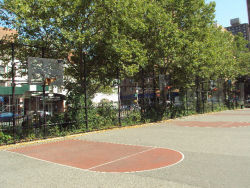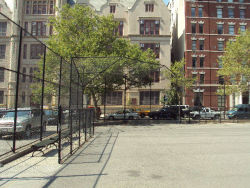Peter's Field
Peter’s Field
Peter’s Field, located between 20th and 21st Streets and First and Second Avenues, is named for two of the city’s most prominent historical figures—Peter Stuyvesant (1610-1672) and Peter Cooper (1791-1905). Nearby Stuyvesant Town, located between Avenue C and First Avenues from 14th to 20th Streets, and Peter Cooper Village, located between Avenue C and First Avenues from 20th Street to 23rd Streets, also bear their names.
Peter Stuyvesant, a Calvinist minister’s son, born in The Netherlands, joined the Dutch West India Company at the age of 22. After becoming the director of the company’s Caribbean colonies of Curaçao, Aruba, and Bonaire in 1643, Stuyvesant led a victorious attack on the island of Saint Martin; he gravely injured his right leg and was forced to have it amputated. The wooden leg he wore from then on earned him the nickname “Old Peg-Leg.” Stuyvesant arrived in New Amsterdam in 1647 as the Director General of New Netherland and quickly worked to limit the sale of liquor, enforce his own church’s domination, and persecute Lutherans, Quakers, and Jews. Stuyvesant bought a farm, the Bouwerie (the namesake of the Bowery), in 1651, and built his home, White Hall, in 1655 at what is now the intersection of Whitehall and State Streets. Often remembered as a violent despot, Stuyvesant also encouraged commerce and helped form New Amsterdam’s municipal government until the British seized New Netherland in 1664. Following his withdrawal from public life, he retired to his farm where he lived until his death in February 1672. Manhattan’s Stuyvesant High School, located in Battery Park City, and Stuyvesant Square Park, from 15th to 17th Streets between Livingston Place and Rutherford Place, are named for him.
New York City native Peter Cooper, an inventor with little formal education, began his career as a cloth cutter during the War of 1812. After becoming a prosperous glue manufacturer, Cooper built the country’s first steam engine, the Tom Thumb, at his Canton Iron Works factory in Baltimore. Deeply involved in New York City politics, he worked to disentangle the fire and police departments from their political connections, to supply better water and sanitation, to improve prison conditions and to provide the poor with public education. The namesake of the Cooper Union for the Advancement of Science and Art (formed between 1857 and 1859), Cooper was an unsuccessful presidential candidate in 1876, when he ran on the Greenback ticket.
Peter’s Field serves the children of M.S. 104, which replaced P.S. 50 in 1956 as part of a comprehensive plan to provide better school facilities for Manhattan’s East Side between Houston and 34th Streets. The post-graduate hospital originally on this site was obsolete after Bellevue Medical Center on First Avenue was completed. The hospital’s demolition in 1963 allowed room for the expansion of Peter’s Field. The park officially opened in 1965, and is jointly operated by NYC Parks and the Department of Education.
In 1998, a renovation of this playground included the addition of tennis courts on the side bordering the school and replacement of basketball courts with more hoops bordering Second Avenue, as well the planting of several London plane trees. A variety of plants decorate the park today including meidiland roses, oakleaf hydrangeas, Japanese barberries, lady's mantle and a host of tulips.
A series of cast concrete plaques, placed in pairs along Second Avenue, depicts other famous Peters: Peter Pan; Peter Parker, Spider Man’s alter ego, shown as half-man, half-spider; Peter Piper, picking pickled peppers; Peter Pumpkin Eater; Peter Rabbit; and Peter of Peter and the Wolf.
Check out your park's Vital Signs
Clean & Safe
Green & Resilient
Empowered & Engaged Users
Share your feedback or learn more about how this park is part of a
Vital Park System


